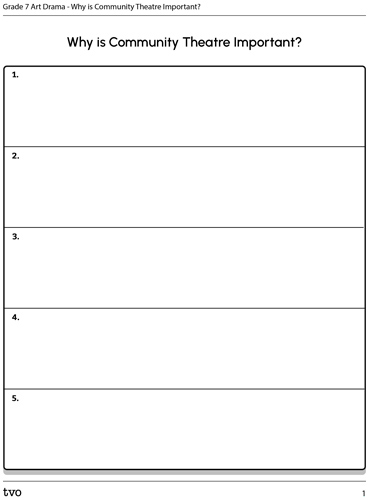Minds On
Warm up

Let’s begin with a breathing activity!
Don’t forget to do your safety check!
Warm Up
Breathing activity
Stand or sit with your shoulders back and your arms at your side.
Breathe in slowly, and if possible, bring your straight arms up above your head as you breathe in and return them to your side as you slowly breathe out.
Repeat this activity slowly 5 times.
Access the following audio recording “Arms Up Breathing Activity” to follow this exercise.
Arms Up Breathing Activity
Drama game
In this activity, we are going to explore the five senses. If possible, choose one of the prompts for three of the senses.
Press the following tabs to access the five senses activity.

Imagine how your body would react as you pretend to touch:
- a hot stove
- icicles
- sharp tacks
- a cozy blanket

Imagine how your body would react as you pretend to taste:
- a sour lemon
- a candy or sweet
- spinach

Imagine how your body would react as you pretend to hear:
- a gentle wind
- underwater sounds
- a whistle

Imagine how your body would react as you pretend to see:
- a car coming far and towards you
- a giant
- an ant
- a big black spider

Imagine how your body would react as you pretend to smell:
- freshly baked bread
- a skunk
- perfume
- onions
Let’s get started!
What is community theatre?
Community theatre, by definition, is a theatre that is managed by a single community. Those who put on the performances are local talent, both on and off the stage.
Community theatre gives a variety of people the opportunity to be a part of a production as well as experience the production at a lower cost than a large city theatre.
Student Success
Think-Pair-Share
Why might it be beneficial or important to have local theatre groups in your community? Consider who might be given opportunities and who might experience this theatre.
Record your thoughts using a method of your choice.
Share your thoughts with a partner, if possible.
Note to teachers: See your teacher guide for collaboration tools, ideas and suggestions.
Action
Community theatre

The importance of community theatre
You have explored some ideas around the importance of community theatre.
Ever since humans came together to share these stories, there has been theatre.
Theatre and live performance play an important role in a community.
A theatre in a community provides the following opportunities:
- It offers jobs for the people who work in the theatre including the crew, design team, those who sell tickets and usher, and the performers themselves.
- It brings people to the community as performers, crew, and audience, which also gives other businesses customers from outside of the community.
- It provides entertainment to those who experience the performances.
These are all important benefits of community theatre. There are also benefits that involve the bringing together of communities. Press the following tabs to learn more.

Theatre gives us a chance to explore a variety of perspectives, as an audience who is experiencing the performance, and the performers who are becoming new characters.

There is a feeling of togetherness that theatre brings. There is a strong sense of community, both as the crew and the performers who are building a story together, but there is also a sense of community as the audience who are experiencing the story together.

Theatre tells stories that are relevant to the social, political, and cultural issues of the past and the present. Stories that are relevant to the community who is performing. These stories give us cultural understanding and continue conversations about important issues.
What life skills does community theatre enhance?
- Drama and theatre teach communication and is a way for people to understand each other.
- Drama and theatre also teach us how to collaborate, how to create, and how to explore.
- It teaches ways of opening up to new perspectives and it teaches how to use body, voice, and face together to communicate a message.
Learning check!
Use your learning to answer the following questions about the importance of community theatre.
Select the correct answer, then press ‘Check Answer’ to see how you did.
Brainstorm
Community theatre search
What community theatre exists in your community or nearby?
Search the internet and find two examples of community theatre either in your community or a neighbouring community.
Complete the Community Theatre Search in your notebook or using the following fillable and printable document. You can also use a method of your choice to record your findings.
Consider adding your work to your portfolio.
Why is community theatre important?
Who determines whether a theatre is strong, vibrant and successful? Is any type of community theatre important?
Imagine you are promoting a community theatre in your area.
- What would you share about the community theatre?
- Why is community theatre important? Who are the members of the community?
Develop 3-5 reasons and complete the Why is Community Theatre Important? fillable document in your notebook or using the following fillable and printable document. You can also record your ideas using another method of your choice.
Consider adding your work to your portfolio.

Press the Activity button to access Why is Community Theatre Important?.
Activity (Open PDF in a new tab)Press ‘Example’ to access a possible answer.
Our community theatre tells stories that are relevant to the social, political, and cultural issues of the time and place that the story takes place. Our theatre gives actors a chance to express themselves, learn and experience new perspectives through the characters they play and experience a sense of community and family. Our theatre gives others a chance to express their creative side through design, construction, and imagination. Our theatre provides a night of discovery, exploration, and education every night it puts on a performance for those who experience it.
The Debajehmujig Theatre Group
In this section, we will learn more about an important community theatre found in Ontario.
Press the following tabs to learn more.
On Manitoulin Island, in Northern Ontario sits an Indigenous theatre company called Debajehmujig Theatre Group. This was the first, and still remains the only, professional theatre company located on a Reserve in Canada.
In 1984, in West Bay, at M’Chigeeng First Nation, Shirlee Cheechoo and Blake Debassige, together with friends and colleagues came together to found this community theatre. In 1989, they brought it to Wikwemikong, a First Nation reserve, where their headquarters is still found today.
This community theatre creates pieces that reflect Anishnaabeg/Chippewa Nation worldview. It supports and promotes Indigenous artists, both on and behind the stage. Its goal is to share the theme of creation with our whole being, which includes our emotional, physical, intellectual, and spiritual selves.
Through the art of storytelling, this community theatre shares Indigenous stories that have been passed down for thousands of years through storytelling, music, and dancing.
‘De-ba-jeh-mu-jig’ means ‘storytellers’ in the Cree and Ojibwe language.
Source: debaj.ca
Learning check!
For each sentence, select the missing word from the drop-down menu.
Check out this video on Debajehmujig storytellers.
Pause and Reflect
Reflection questions
Reflect on the following questions.
- What is the purpose of the Debajehmujig Storytellers?
- How old are some of the stories being shared by this group?
- What important gap is this group bridging for members of their community?
Record your thoughts using a method of your choice. Consider adding your work to your portfolio.
Press ‘Answer’ to access possible responses.
To expose their great, great, great great-grandchildren to the same stories shared with them by their great, great, great great-grandparents. Some of these stories go back 50,000 years. There are grandchildren who don’t speak the traditional language and grandparents who only speak the traditional language. Through storytelling, they are bridging the gap and allowing these groups to communicate with each other and pass the stories on.
Exploring the story “The Three Sisters”
This video is a clip created by the Debajehmujig Storytellers that tells the story of the “Three Sisters.”
Explore the story. What do you notice? What do you wonder?
Reflect
- Who do the Three Sisters represent? Consider how they are described.
- What value do the Three Sisters bring to their community?
Press ‘Answer’ to access a possible response.
The Three Sisters represent corn, beans, and squash. The Three Sisters will feed their community through the year, including the winter months.
Did You Know?
Did you know?

The following information explains the importance of The Three Sisters. “Before European contact, the Oneida diet consisted mainly of corn, beans and squash. These foods were named The Three Sisters. The Oneida people’s vast gardens allowed them to consume these foods year-round. Anything else, such as wild game and fish, had to be in season, as well as fruits and nuts harvested from trees. After contact, many Indigenous people contracted diabetes and high blood pressure due to eating processed food.”
Source: FNMIEAO, The Three Sisters
Interview in role

Imagine you are going to play the role of a reporter. You would like to interview the Debajehmujig Theatre Group in the Wiikwemkoong Unceded Territory on Manitoulin Island.
You have sent a request to the company, and now must decide on the questions you will ask. You value community theatre and recognize the value and importance of theatre groups which represent the stories of their community history and members.
What would you like to learn about from the Debajehmujig Theatre Group?
If you interviewed people involved in drama or theatre in the community (e.g., actors, directors, theatre group members, playwrights, designers), what could you ask them about the value they place on theatre as part of their own lives and the life of the community?
Create 5-7 questions you would like to include in your interview. You can record your questions using the Interview Questions in your notebook or using the following fillable and printable document. You can also use another method of your choice to record your interview.
Consider adding your work to your portfolio.
Press ‘Example’ to access possible interview questions.
What is one production that you are especially proud of? Why?
Where do your performers come from? Have you ever had student performers?
Consolidation
Presentation for community theatre

Imagine you had to give a presentation to convince members of your municipal government that the community theatre in your neighbourhood is a vital part of the community.
Consider adding the following information to your presentation.
My presentation includes the following…
Present your presentation to a partner, if possible. You may also create a video or audio recording or a written version with visuals.
Portfolio
Journal reflection
Reflect on the learning tasks. This reflection is a space for you to express your feelings, ask questions about what you have just done, and connect thoughts together with specific activities or exercises.
Use 3-5 of the journal prompts from the Reflection Starters list and create a written, audio, or video reflection.
|
Prompts to Start a Reflection on Drama Class Note: The following prompts begin an entire thought and can be used to develop your thoughts and ideas. Note: Try to utilize three of the prompts provided. If there is something else you wish to share, continue to build on your ideas. Note: Explore your thoughts and feelings with direct reference to what you learned and explored within the lesson. I really liked it when I did____________, because… I really want to know more about____________, because… I’m really happy about____________, because… If I were to sum up my experience in this lesson in one word it would be__________, because… When I think about what I accomplished in this task, I think about… When I learned about_________, it made me feel__________, because… |
Press the ‘Activity’ button to access Reflection Starters.
Reflection
As you read the following descriptions, select the one that best describes your current understanding of the learning in this activity. Press the corresponding button once you have made your choice.
I feel…
Now, expand on your ideas by recording your thoughts using a voice recorder, speech-to-text, or writing tool.
When you review your notes on this learning activity later, reflect on whether you would select a different description based on your further review of the material in this learning activity.

